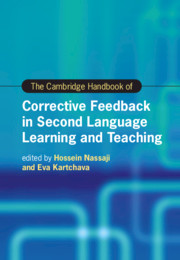Book contents
- The Cambridge Handbook of Corrective Feedback in Second Language Learning and Teaching
- Cambridge Handbooks in Language and Linguistics
- The Cambridge Handbook of Corrective Feedback in Second Language Learning and Teaching
- Copyright page
- Contents
- Figures
- Tables
- Contributors
- Acknowledgments
- Introduction Corrective Feedback in Second Language Teaching and Learning
- Part I Theoretical Perspectives on Corrective Feedback
- 1 Corrective Feedback from Behaviorist and Innatist Perspectives
- 2 Interactionist Approach to Corrective Feedback in Second Language Acquisition
- 3 Cognitive Theoretical Perspectives of Corrective Feedback
- 4 Corrective Feedback from a Sociocultural Perspective
- Part II Methodological Approaches in the Study of Corrective Feedback
- Part III Different Delivery Modes of Corrective Feedback
- Part IV Feedback Provider, Feedback Intensity, and Feedback Timing
- Part V Corrective Feedback and Language Skills
- Part VI Contexts of Corrective Feedback and Their Effects
- Part VII Learners’ and Teachers’ Feedback Perspectives, Perceptions, and Preferences
- Part VIII Individual Differences, Tasks, and Other Language- and Learner-Related Factors
- Index
- References
1 - Corrective Feedback from Behaviorist and Innatist Perspectives
from Part I - Theoretical Perspectives on Corrective Feedback
Published online by Cambridge University Press: 26 February 2021
- The Cambridge Handbook of Corrective Feedback in Second Language Learning and Teaching
- Cambridge Handbooks in Language and Linguistics
- The Cambridge Handbook of Corrective Feedback in Second Language Learning and Teaching
- Copyright page
- Contents
- Figures
- Tables
- Contributors
- Acknowledgments
- Introduction Corrective Feedback in Second Language Teaching and Learning
- Part I Theoretical Perspectives on Corrective Feedback
- 1 Corrective Feedback from Behaviorist and Innatist Perspectives
- 2 Interactionist Approach to Corrective Feedback in Second Language Acquisition
- 3 Cognitive Theoretical Perspectives of Corrective Feedback
- 4 Corrective Feedback from a Sociocultural Perspective
- Part II Methodological Approaches in the Study of Corrective Feedback
- Part III Different Delivery Modes of Corrective Feedback
- Part IV Feedback Provider, Feedback Intensity, and Feedback Timing
- Part V Corrective Feedback and Language Skills
- Part VI Contexts of Corrective Feedback and Their Effects
- Part VII Learners’ and Teachers’ Feedback Perspectives, Perceptions, and Preferences
- Part VIII Individual Differences, Tasks, and Other Language- and Learner-Related Factors
- Index
- References
Summary
The nature of the linguistic knowledge that ensues is the sine qua non of theoretical controversies surrounding corrective feedback. This chapter effectively brings that to light through an in-depth discussion of two polarized theoretical perspectives: the behaviorist and the innatist. The chapter provides a pathway to understanding the epistemological differences underlying the ebbs and flows of interest in corrective feedback that the field of applied linguistics has witnessed over the past five decades, arguing that heeding the eclectic insights from both perspectives would greatly benefit future research and practice.
Keywords
Information
- Type
- Chapter
- Information
- The Cambridge Handbook of Corrective Feedback in Second Language Learning and Teaching , pp. 23 - 43Publisher: Cambridge University PressPrint publication year: 2021
References
Accessibility standard: Unknown
Why this information is here
This section outlines the accessibility features of this content - including support for screen readers, full keyboard navigation and high-contrast display options. This may not be relevant for you.Accessibility Information
- 4
- Cited by
